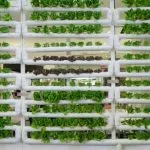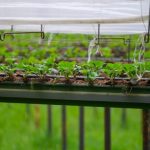If you’re interested in hydroponics, you’ve probably heard of Nutrient Film Technique (NFT). NFT is a popular hydroponic system that uses a shallow stream of nutrient-rich water to grow plants. How does nutrient film technique work and why is it important in hydroponics? We’ll answer these questions and more in this blog post!
Dr. Allan Cooper of the Glasshouse Crops Research Institute in the United Kingdom developed (NFT) in the late 1960s as a way to grow crops in limited space and with limited resources. Since then, it has become a popular method for growing plants indoors and in urban environments. NFT is particularly popular for growing leafy greens and herbs, but it can be used to grow a wide variety of plants.

One of the main benefits of NFT is that it allows plants to absorb nutrients and water more efficiently than traditional soil-based methods. This is because the nutrient solution is constantly flowing through channels over the roots, providing them with a steady supply of nutrients and oxygen. This results in faster growth and higher yields.
In the next sections, we’ll dive deeper into how NFT works, its pros and cons, how to set up an NFT system, and how to maintain it. Whether you’re a seasoned hydroponics enthusiast or just getting started, you’ll find valuable information in this post. So, let’s get started!
What is Nutrient Film Technique (NFT)?
Nutrient Film Technique (NFT) is a highly effective hydroponic system that utilizes a thin film of nutrient solution flowing over the plant roots. By understanding the basic principles of NFT and its unique features, we can appreciate its significance in modern agriculture.
Nutrient Film Technique Definition: Harnessing Nutrient Flow for Plant Growth
NFT is a hydroponic cultivation method where plants are grown in a sloped channel or tube. Unlike traditional soil-based systems, NFT relies on a continuous flow of nutrient solution to nourish the plants. This controlled and targeted delivery system ensures that plants receive a consistent supply of vital nutrients, promoting optimal growth and development.
The Role of the Thin Film: Nutrient Solution at the Roots
The key principle of NFT lies in the thin film of nutrient solution that flows over the plant roots. This film creates a direct interface between the roots and the nutrient-rich solution, allowing for efficient nutrient absorption. As the solution gently trickles over the roots, it carries essential elements that the plants need for their metabolic processes. This nutrient film provides a constant supply, ensuring plants have access to the necessary resources for robust growth.
The Sloped Channel or Tube: Maintaining the Flow
A sloped channel or tube is a crucial component of NFT systems. It facilitates the continuous flow of the nutrient solution, ensuring it moves smoothly from one end to the other. The slope of the channel or tube is carefully designed to optimize the NFT hydroponics flow rate, preventing stagnation and allowing for proper distribution. This consistent flow is essential for providing a steady supply of nutrients to all plants within the system.
Oxygenation and Root Development: Keys to Success
In NFT, proper oxygenation of the plant roots is paramount. The continuous flow of the nutrient solution creates an oxygen-rich environment around the roots, enabling efficient gas exchange. Adequate oxygenation supports healthy root development and enhances overall plant vitality. The roots can perform their essential functions, including nutrient uptake, water absorption, and anchoring the plant securely.
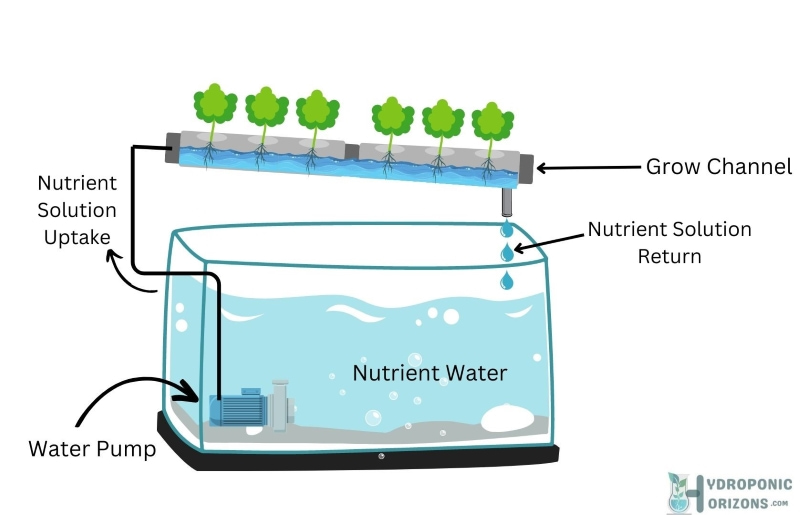
Key Components of NFT Hydroponic Systems
Channel Design and Setup: Constructing the Pathway for Nutrient Flow
In NFT systems, the design and construction of channels play a crucial role in facilitating the flow of the nutrient solution to the plant roots. Consider the following aspects when setting up NFT channels:
– Design and Construction: NFT channels are typically made of durable materials such as PVC, polyethylene, or acrylic. These materials are resistant to water damage and provide a smooth surface for the nutrient film to flow without obstruction.
– Channel Slope and Dimensions: To ensure optimal nutrient flow, the channels should have a slight slope, typically ranging from 1:30 to 1:40. This slope encourages the nutrient solution to flow consistently from the higher end to the lower end of the channel. The dimensions of the channels depend on the specific requirements of the crops being cultivated. Here’s a list of recommended nutrient film technique plants that grow well in this system.
Pump and Reservoir: Ensuring Proper Nutrient Circulation and Storage
The pump and reservoir are vital components of NFT systems, responsible for maintaining the circulation and availability of the nutrient solution:
– Pump Function: The pump plays a crucial role in circulating the nutrient solution through the NFT system. It ensures a continuous flow of the solution, allowing it to reach the plant roots and deliver the necessary nutrients. A reliable pump with adjustable flow settings is essential to accommodate different crop types and growth stages.
– Reservoir Importance: The reservoir serves as a storage container for the nutrient solution. It should be appropriately sized to hold an adequate volume of solution to meet the needs of the plants. Regular monitoring of the reservoir is necessary to maintain optimal nutrient levels and pH. Adjustments may be required to ensure the nutrient solution remains balanced and conducive to plant growth.
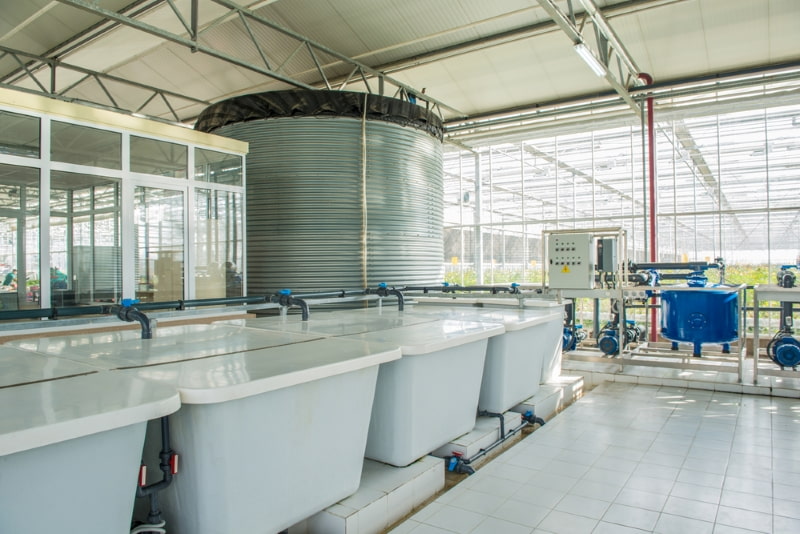
Growing Medium and Plant Support: Providing Stability and Root Contact
In NFT systems, the choice of growing medium and plant support structures significantly influences plant growth and stability:
– Growing Medium Role: While NFT primarily relies on the thin film of nutrient solution, a growing medium is often used to provide support for the plants and aid in moisture retention. Common options include Rockwool, coconut coir, or other inert substrates that allow roots to establish contact with the nutrient film while offering stability and moisture management.
– Plant Support Structures: Plant support structures, such as trellises or netting, are essential for vertical growth and preventing plants from falling into the nutrient film. These structures provide stability, promote proper plant positioning, and ensure consistent contact between the roots and the nutrient solution.
Related: Now that you know about all the components, it’s time to learn how to build an NFT hydroponic system. Or you can take the convenient route if you’re just starting and buy a full NFT system setup instead.
Nutrient Delivery and Management in NFT
Nutrient Solution Composition: Maintaining a Balanced Formula
In NFT systems, maintaining a balanced nutrient solution is crucial for optimal plant growth and development. Consider the following factors when managing the composition of the nutrient solution:
– Importance of Balance: A balanced nutrient solution provides plants with the essential elements they need to thrive. It should include macronutrients such as nitrogen (N), phosphorus (P), and potassium (K), as well as micronutrients like iron (Fe), zinc (Zn), and manganese (Mn). Each nutrient plays a specific role in plant metabolism and must be present in the right proportion for healthy growth.
– Essential Macronutrients and Micronutrients: Nitrogen is necessary for leaf and stem growth, while phosphorus supports root development and flower/fruit production. Potassium aids in overall plant health and disease resistance. Micronutrients, although required in smaller quantities, are equally important for enzymatic reactions and essential plant functions.
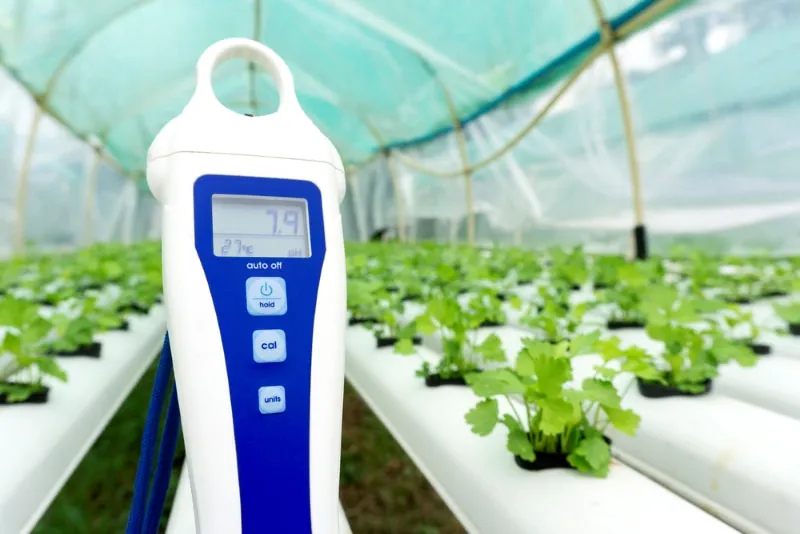
– Nutrient Solution Concentration and pH Levels: The concentration of the nutrient solution should be carefully adjusted according to the specific crop requirements and growth stages. It is essential to follow recommended guidelines and monitor the electrical conductivity (EC) levels to prevent nutrient imbalances. Additionally, maintaining the pH of the solution within the appropriate range (usually around 5.5 to 6.5) ensures optimal nutrient availability and uptake.
Nutrient Solution Flow Rate and Timing: Ensuring Adequate Delivery
Proper management of the nutrient solution flow rate and timing is critical in NFT systems to ensure plants receive adequate nourishment. Consider the following aspects when determining the flow rate and timing:
– Optimal Flow Rate: The nutrient solution should flow at a rate that allows for proper distribution without causing excessive runoff or pooling. Aim for a gentle and uniform flow that covers the entire root zone. A flow rate of approximately 1 to 2 liters per minute per square meter is often suitable, but it may vary depending on the crop’s water and nutrient requirements.
– Frequency and Duration: The frequency and duration of nutrient solution delivery depend on factors such as plant growth stage, environmental conditions, and the specific crop being cultivated. Typically, the nutrient solution is delivered for a specific duration multiple times throughout the day. Frequent but shorter cycles can ensure a steady supply of nutrients while preventing waterlogging or drying out of the root zone.
– Consistent Monitoring and Adjustment: Regular monitoring of the plants and the nutrient solution is essential to detect any signs of nutrient deficiencies or imbalances. Monitoring the pH and EC levels of the nutrient solution, as well as observing plant health and growth, allows for timely adjustments. It may be necessary to fine-tune the flow rate, timing, or nutrient solution concentration to address any issues and maintain optimal nutrient delivery.
Related: Learn a bit about all the other hydroponic systems and their components in our extensive guide, Hydroponics 101.
Advantages and Considerations of NFT
Advantages of NFT: Unlocking the Potential of Hydroponics
There are several nutrient film technique advantages and disadvantages that make it a popular but challenging choice for hydroponic cultivation. Consider the following benefits when considering NFT for your growing system:
– Efficient Water and Nutrient Use: NFT systems are designed to be highly efficient in water and nutrient usage. The thin film of nutrient solution flowing over the roots allows for precise delivery, reducing water waste compared to traditional soil-based methods. Additionally, the controlled nutrient solution ensures that plants receive the required elements, minimizing nutrient runoff and optimizing resource utilization.
– Potential for Higher Yields: NFT systems provide plants with a consistent supply of nutrients, water, and oxygen. This optimal growing environment promotes vigorous plant growth, resulting in higher yields. With the right nutrient management and environmental control, NFT can help maximize the productivity of your hydroponic setup.
– Faster Plant Growth: The continuous flow of the nutrient solution in NFT systems helps stimulate root development and nutrient uptake. This accelerated nutrient absorption, coupled with the ideal growing conditions, promotes faster plant growth. With NFT, you can expect shorter cultivation cycles and quicker harvests compared to traditional soil-based methods.
– Space efficiency: NFT allows plants to grow vertically, making it a great option for urban settings or small indoor spaces where horizontal space is limited.
Nutrient Film Technique Problems and Overcoming Challenges
While NFT offers numerous advantages, it is essential to be aware of potential challenges and considerations to ensure successful implementation. Take the following into account when setting up and maintaining an NFT system:
– Root Clogging: In NFT, the narrow channels through which the nutrient solution flows can be susceptible to root clogging. It is crucial to regularly inspect and maintain the channels, ensuring there are no blockages that could impede the flow. Monitoring root growth and periodically cleaning the channels can help prevent clogging issues.
– Algae Growth: NFT systems, with their constant flow of nutrient solution, can create an ideal environment for algae growth. Algae can compete with plants for nutrients and block the light reaching the roots. Implementing preventive measures such as light-blocking covers for the channels and regular sanitization can help control algae growth and maintain system efficiency.
– System Maintenance: NFT systems require regular maintenance to ensure optimal performance. Monitoring nutrient solution levels, pH, and EC is necessary to prevent imbalances and adjust as needed. Regular inspection of the system components, such as pumps and channels, helps identify any issues early on and maintain the system’s functionality.
– Troubleshooting Common Problems: It is important to be prepared to troubleshoot common problems that may arise in NFT systems. Issues such as nutrient deficiencies, pH fluctuations, or uneven flow can impact plant health. Understanding the symptoms and potential causes of these problems allows for timely intervention and adjustment to keep the plants thriving.



